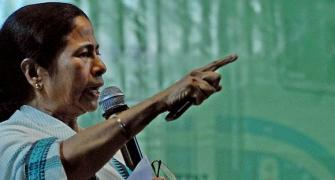 In Khapistan, where rape is a cottage industry, a local politician paraphrases the Manusmriti and suggests that boys and girls should be married off as soon as possible to prevent rape, says Devangshu Datta
In Khapistan, where rape is a cottage industry, a local politician paraphrases the Manusmriti and suggests that boys and girls should be married off as soon as possible to prevent rape, says Devangshu Datta
Roughly half the men in the global workforce are actually women -- a huge change from 1912, when the ratio was 95:5 in favour of men. That was roughly when an entire generation of women collectively declared that they would not be dictated to and started changing the odds by becoming steno-typists.
The induction of women into the workforce was helped along by the First World War and then the Second, when European women had to take over many civilian occupations and walked into support military roles as well while the men were conscripted. Along the way, they got the vote, and so on. Incidentally, the three highest-scoring snipers in WWII were all women.
One would have expected that gender biases would have changed somewhere along the way. In Edwardian England, for example, it was genuinely believed by some quite intelligent people that women couldn't take the pressure of voting, or the strain of studying sciences, or holding high-pressure jobs.
Where are we now? In most places, there is still a glass ceiling and men also get paid more for doing the same work. Obviously, attitudes differ from nation to nation. An unsystematic but revealing sampling of events in the last few weeks should offer some clues about gender attitudes.
In Pakistan, the Taliban (ironically this means "student") shoots a little girl for wanting to go to school and proudly takes responsibility for gunning her down, citing some 7th century justification. When there is a backlash in public opinion, the Taliban mounts a counter-campaign to vilify the little girl who they shot.
In neighbouring Afghanistan, a woman is beheaded for refusing to become a prostitute. This is Catch-22. She would have been stoned to death if she had become a prostitute.
In Khapistan, where rape is a cottage industry, a local politician paraphrases the Manusmriti and suggests that boys and girls should be married off as soon as possible to prevent rape. This is hailed by other Khapistanis as a sophisticated experiment in data-massaging. Indian jurisprudence is reluctant to recognise marital rape so the stats would indeed drop if the young men stuck to raping their respective child-brides and didn't seek excitement outside their marriages.
Another leading light of Khapistan indicts the unbridled consumption of chowmein as a precursor to rape. This stumps everybody. Some earnest researchers look up rape stats in nations known for high noodle consumption and discover oddly enough, that there are fewer crimes against women in China, Japan and Italy.
In Bengal, the chief minister says rape stats have jumped because of the free mixing of men and women. It's not very clear why, since Bengal is one of the few places in India where men and women have been mixing freely for generations. It becomes even less clear when she asserts that rapes in West Bengal are all part of some plot to vilify her administration.
In a more evolved society, a presidential candidate makes an immortal remark about "binders full of women" when he is seeking to justify gender-unequal hiring policies. He also believes that abortion is only justified in cases of incest, rape, and so on. One of his partymen has earlier claimed that rape sperm are automatically prevented from causing pregnancy by some mysterious process mandated by God.
Meanwhile in Australia, a woman prime minister points out that the leader of the opposition stood by and laughed while the younger members of his party called her a "bitch". In France, a presidential hopeful runs into a spot of bother in the criminal courts after he is linked to a prostitution ring he has already survived a charge of rape in the US.
Just one century is obviously not enough to reverse the prejudices of millennia. How many more is it likely to take?









